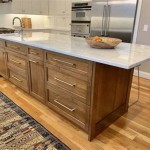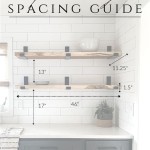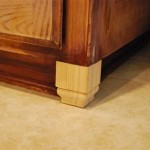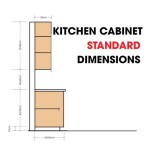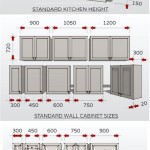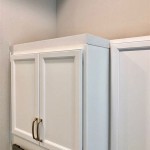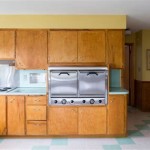Shabby Chic Kitchen Cabinets: A Detailed Exploration
Shabby chic kitchen cabinets represent a distinct aesthetic within interior design, embodying a blend of vintage charm, comfortable informality, and a deliberately aged appearance. This style, often associated with a relaxed and lived-in ambiance, has gained considerable popularity among homeowners seeking to create a warm and inviting kitchen space. Understanding the elements that define shabby chic cabinets, the materials and techniques employed in their creation, and the strategies for incorporating them into a cohesive kitchen design is essential for achieving the desired effect.
The core of the shabby chic aesthetic lies in its celebration of imperfections and the patina of age. Unlike modern minimalist styles or sleek contemporary designs, shabby chic actively embraces signs of wear, such as distressed paint finishes, chipped edges, and the subtle variations in tone that come with time. This emphasis on authenticity and character distinguishes it from mass-produced furniture and lends a unique personality to the kitchen.
The color palette typically associated with shabby chic kitchens revolves around soft, muted tones. Whites, creams, pale pinks, light blues, and gentle grays are common choices, creating a light and airy atmosphere. These colors complement the aged appearance of the cabinets and contribute to the overall sense of tranquility. While bolder colors may occasionally be incorporated as accents, the dominant impression is one of understated elegance and subtle sophistication.
Beyond the color scheme and distressed finishes, the hardware and accessories chosen for shabby chic kitchen cabinets play a crucial role in defining the style. Vintage-inspired knobs and pulls, often crafted from materials like porcelain, glass, or antique brass, add an extra layer of authenticity and visual interest. These details contribute to the overall sense of history and craftsmanship that is characteristic of the shabby chic aesthetic.
Key Point 1: Understanding the Distinguishing Features of Shabby Chic Cabinets
Several features distinguish shabby chic cabinets from other kitchen cabinet styles. The most prominent of these is the distressed finish, which is intentionally created to mimic the appearance of age and wear. This can be achieved through various techniques, including sanding, layering different paint colors, and applying antiquing glazes. The goal is to create a surface that appears to have been gently weathered over time, revealing hints of underlying colors and textures.
Another defining characteristic is the use of soft, muted colors. White is a particularly popular choice, often used as a base coat or as the dominant color for the entire cabinet. Cream, ivory, and other off-white shades are also frequently employed, creating a warm and inviting ambiance. Pastel colors, such as pale pink, light blue, and mint green, can be incorporated as accents or to add a touch of whimsy.
The hardware selected for shabby chic cabinets further enhances their vintage appeal. Antique-style knobs and pulls, crafted from materials like porcelain, glass, or tarnished metal, are commonly used. These details add a touch of elegance and refinement, complementing the distressed finish and soft color palette. The hardware often features intricate designs or decorative embellishments, further contributing to the overall sense of charm.
The style of the cabinet doors themselves also contributes to the shabby chic aesthetic. Raised panel doors, with their intricate detailing and classic proportions, are frequently used. Shaker-style doors, with their simple and clean lines, can also be incorporated, particularly in kitchens with a more minimalist or contemporary interpretation of the shabby chic style. Glass-front cabinets allow for the display of vintage dishes and decorative items, further enhancing the overall sense of charm and character.
The deliberate imperfection is a key element. Knots in the wood, slight variations in color, and other minor flaws are embraced as part of the cabinet's unique character. This contrasts sharply with the perfectly smooth and uniform surfaces that are characteristic of many modern cabinet styles.
Key Point 2: Materials and Techniques Used in Creating Shabby Chic Cabinets
The creation of shabby chic kitchen cabinets involves a variety of materials and techniques, each contributing to the overall aesthetic. Wood is the most common material used for the cabinet frames and doors, with options ranging from hardwoods like maple and oak to softer woods like pine. The choice of wood will depend on factors such as budget, desired durability, and the specific look that is being pursued.
Paint is arguably the most important element in achieving the distressed finish that is characteristic of shabby chic cabinets. Multiple layers of paint are often applied, with each layer sanded or scraped to reveal the colors beneath. This creates a layered, textured effect that mimics the appearance of age and wear. Chalk paint, known for its matte finish and ease of distressing, is a popular choice for shabby chic cabinets.
Various techniques can be used to create the distressed finish. Sanding is a common method, used to remove paint from edges, corners, and other areas that would naturally experience wear over time. Dry brushing, a technique in which a brush with very little paint is applied to the surface, can create a subtle, textured effect. Antiquing glazes can be applied to add depth and dimension, highlighting the details of the cabinet doors and creating a sense of age.
The use of sandpaper is critical. Different grits of sandpaper can be used to achieve different levels of distressing, from light sanding that simply softens the edges to more aggressive sanding that reveals the underlying wood. Experimentation is often necessary to find the right balance that achieves the desired effect.
In addition to paint and distressing techniques, hardware plays a crucial role in completing the shabby chic look. Vintage-inspired knobs and pulls, crafted from materials like porcelain, glass, or antique brass, are commonly used. These details add a touch of elegance and refinement, complementing the distressed finish and soft color palette. The hardware often features intricate designs or decorative embellishments, further contributing to the overall sense of charm.
Sometimes, reclaimed wood is incorporated into the construction of shabby chic cabinets. This adds an element of authenticity and sustainability, as the wood already possesses the desired aged appearance and inherent character. Reclaimed wood can be used for the cabinet frames, doors, or even as decorative accents.
Key Point 3: Incorporating Shabby Chic Cabinets into a Kitchen Design
Integrating shabby chic cabinets into a cohesive kitchen design requires careful consideration of the surrounding elements, including countertops, flooring, backsplash, and accessories. The goal is to create a space that feels harmonious and balanced, reflecting the relaxed and inviting nature of the shabby chic aesthetic.
Countertops play a crucial role in complementing shabby chic cabinets. Materials like marble, granite, or butcher block are often used, adding a touch of elegance and sophistication. Light-colored countertops, such as white marble or cream-colored granite, can help to brighten the space and create a sense of airiness. Butcher block countertops, with their warm and natural tones, can add a rustic touch.
Flooring choices should also complement the shabby chic aesthetic. Hardwood floors, with their natural warmth and character, are a popular choice. Wide plank flooring, with its rustic appeal, can further enhance the overall sense of charm. Tile flooring in soft, muted tones can also be used, adding a touch of elegance and sophistication.
The backsplash provides an opportunity to add visual interest and texture to the kitchen. Subway tile, with its classic and timeless appeal, is a popular choice. Beadboard, with its vertical lines and textured surface, can also be used, adding a touch of country charm. Glass tile in soft, muted tones can create a subtle and sophisticated effect.
Accessories and decorative items play a crucial role in completing the shabby chic look. Vintage dishes, antique silverware, and other decorative objects can be displayed on open shelves or in glass-front cabinets. Fresh flowers, potted plants, and other natural elements can add a touch of life and vibrancy to the space. Linens in soft, muted tones can be used to add warmth and texture.
Lighting also plays a significant role in creating the desired ambiance. Vintage-inspired pendant lights, chandeliers, and sconces can add a touch of elegance and sophistication. Natural light should be maximized to create a bright and airy space. The overall lighting scheme should be warm and inviting, contributing to the relaxed and comfortable atmosphere.
The layout of the kitchen itself can also contribute to the shabby chic aesthetic. Open shelving, rather than closed cabinets, can create a more relaxed and informal atmosphere. A farmhouse sink, with its deep basin and exposed front, can add a touch of country charm. A kitchen island, with a distressed finish and vintage-inspired hardware, can serve as a focal point for the space.
Ultimately, the key to successfully incorporating shabby chic cabinets into a kitchen design is to create a space that feels authentic and personal. Embrace imperfections, celebrate the patina of age, and choose elements that reflect individual style and preferences. The result will be a kitchen that is both beautiful and inviting, a true reflection of the shabby chic aesthetic.

Rustic Yet Soft The Shabby Chic Kitchen

My Favorite Kitchens Of 2010 Chic Kitchen Decor Shabby Cabinets

Home Deco Ideas Shabby Chic Kitchen Cabinets Cabinet

12 Inspiring Shabby Chic Kitchens Kitchen Cabinets Decor

34 Charming Shabby Chic Kitchens You Ll Never Want To Leave Kitchen Decor

52 Charming Shabby Chic Kitchens You Ll Love Digsdigs

25 Stunning Shabby Chic Kitchen Design Ideas Cabinets Decor

5 Shabby Chic Kitchens You D Surely Love

How To Design A Shabby Chic Kitchen

Kitchens Shabby Chic Design Ideas
Related Posts

